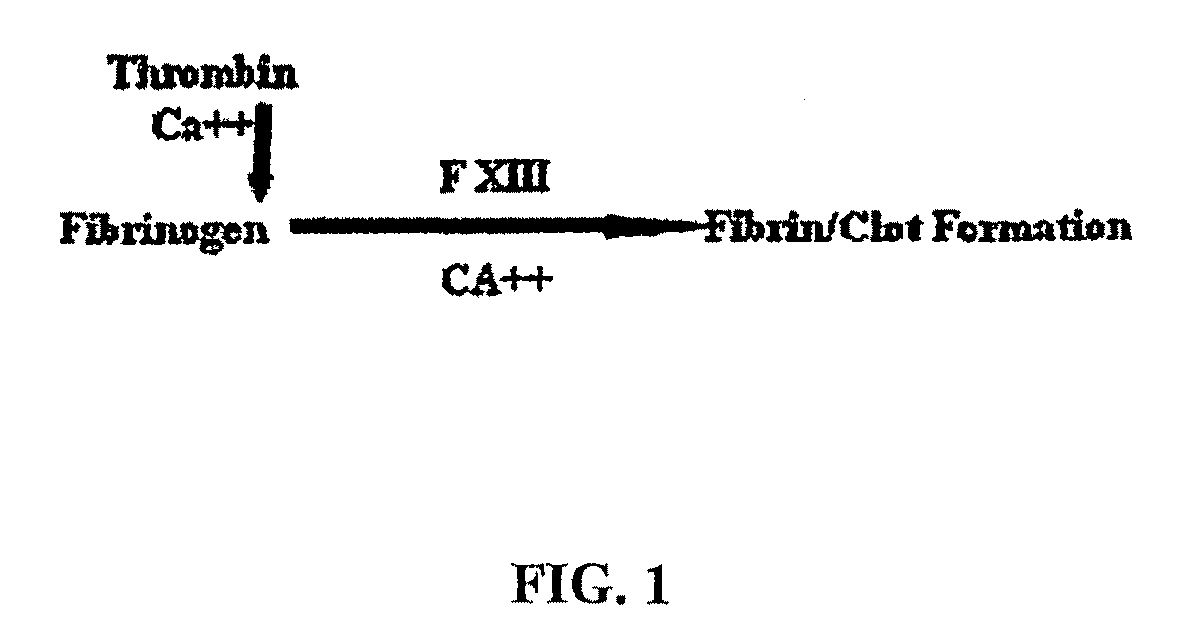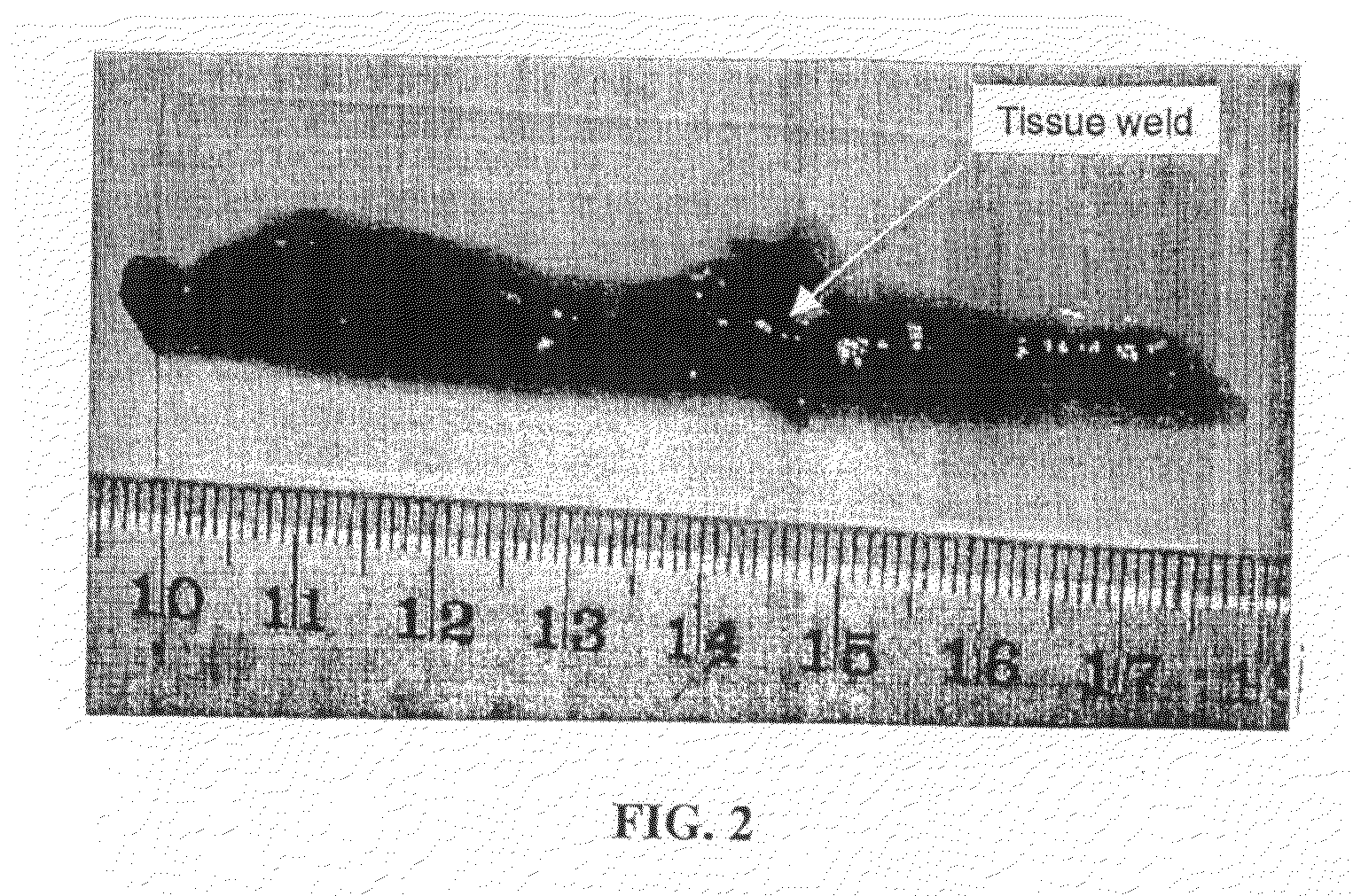Joining and/or Sealing Tissues Through Photo-Activated Cross-Linking of Matrix Proteins
- Summary
- Abstract
- Description
- Claims
- Application Information
AI Technical Summary
Benefits of technology
Problems solved by technology
Method used
Image
Examples
example 1
Photochemical Cross-Linking of Bovine Fibrinogen
[0099]A photochemical method was used to cross-link the soluble fibrinogen into a solid biomaterial and to effect the covalent cross-linking of the fibrinogen matrix to the proteins contained in the extracellular matrix surrounding the muscle tissue. Two small strips of bovine longissimus dorsi (LD) were dissected and the opposing surfaces coated in the sealant solution (200 mg / ml bovine fibrinogen was dissolved in PBS, with 2 mM (Ru(bpy)3]Cl2, 10 mM ammonium persulfate). Following 10 sec of irradiation, the two pieces of muscle were firmly attached at the position shown in FIG. 2. The light source chosen for the present study was a 600-W tungsten-halide source (2×300-W lamps; GE #38476). The spectral output showed a broad peak from 300 nm-1200 nm. Bovine fibrinogen (Fraction I, Sigma) (200 mg / ml) was dissolved in PBS, with 2 mM [Ru(bpy)3]Cl2, 10 mM ammonium persulfate) and photochemically cross-linked (600 W at 10 cm for 10 s).
example 2
[0100]Degradation of and Tissue Response to Polymerised Fibrinogen Biopolymers in vivo
[0101]The solid fibrinogen biomaterial to be evaluated in the rat subcutaneous implant study is derived from a purified soluble fibrinogen protein which was crosslinked using a photochemical method involving Tris(bipyridyl) Ruthenium (II) chloride (2 mM final concentration) and ammonium persulphate (20 mM final concentration). The light source chosen for these studies was a 600-W tungsten-halide source (2×300-W lamps; GE #38476). The spectral output showed a broad peak from 300 nm-1200 nm. Preliminary in vitro cytotoxicity evaluations on this purified expressed protein biomaterial had been encouraging however further, standard cell culture methods to screen for direct and leachable potential toxic components were required prior to implantation in animals. Therefore the fibrinogen biomaterials were evaluated in rats for tissue responses as well as the extent of degradation of the material over a 36 ...
example 3
Strength of Fibrinogen-Based Tissue Sealant (FBTS).
[0115]The comparative strength of tissues joined using FBTS and tissues joined using fibrin glue was measured using de-fleeced adult sheep skin. Skin was de-haired and the dermal surface scraped clean using a wire brush. The skin was soaked in phosphate-buffered saline (PBS) and “dumbbells” (ca. 10 cm×1 cm) were cut from the re-hydrated skin for tensile testing. An incision was made across the width of a dumbbell shaped strip of skin, and the two halves then “glued” or sealed (at room temperature) following photochemical treatment of fibrinogen in accordance with the present invention. The adhesive properties of FBTS was compared with a commercial fibrin-based tissue sealant (Tisseel™-Baxter), used as instructed by the manufacturer. The glued skin was then mounted in a tensile testing instrument (Instron) and tested for load to break. The units are Newtons (N). The cut dumbbells were either overlapped by 1 cm at the join or were but...
PUM
| Property | Measurement | Unit |
|---|---|---|
| Molar density | aaaaa | aaaaa |
| Molar density | aaaaa | aaaaa |
| Molar density | aaaaa | aaaaa |
Abstract
Description
Claims
Application Information
 Login to View More
Login to View More - R&D
- Intellectual Property
- Life Sciences
- Materials
- Tech Scout
- Unparalleled Data Quality
- Higher Quality Content
- 60% Fewer Hallucinations
Browse by: Latest US Patents, China's latest patents, Technical Efficacy Thesaurus, Application Domain, Technology Topic, Popular Technical Reports.
© 2025 PatSnap. All rights reserved.Legal|Privacy policy|Modern Slavery Act Transparency Statement|Sitemap|About US| Contact US: help@patsnap.com



